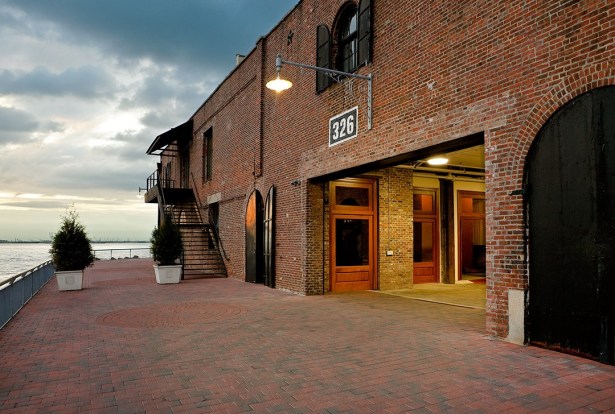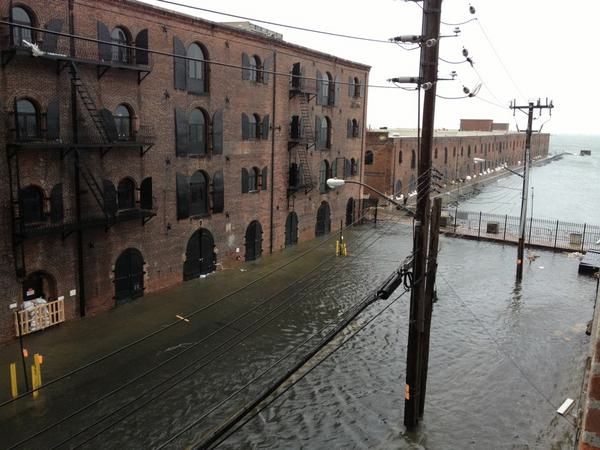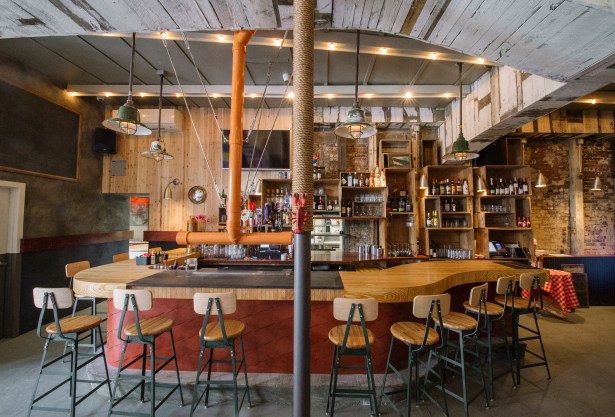Red Hook Was Crushed by Superstorm Sandy, but Dusted Itself Off and Came Back Better
By Larry Getlen October 26, 2016 9:00 am
reprints
Inside Liberty Warehouse, an event space that abuts the Buttermilk Channel in the Red Hook neighborhood of Brooklyn, General Manager Jeff Torem showed Commercial Observer a line, about four feet above the ground, that ran across the bottom of an antique mirror.
This is the water line, the mark that shows how high the water rose during Superstorm Sandy.
“You can see it here. This is a really expensive mirror that got destroyed,” said Torem, who also pointed out sections of the wooden floor that have been replaced in a piecemeal fashion.
“Some of [the floor] still comes up, so we replace it,” he said. “We’re replacing patches [a bit] at a time.”
Superstorm Sandy seriously impacted New York City, the suburbs and Long Island. Nearly 50 people died in the Big Apple and others lost homes, vehicles and businesses. Red Hook, Brooklyn, falls in the hurricane evacuation zone. It was a neighborhood that—despite the fact that it was separated from any subway lines—had become more desirable in recent years, with restaurants and businesses slowly popping up. But given its proximity to the water, residents were forced to evacuate, and businesses left with no choice but to shutter.
To commemorate the storm’s fourth anniversary, CO spoke to business owners in Red Hook about what they went through that fateful day, and how their companies not only survived but in many cases came back stronger and more prosperous.
Torem had been general manager of the two-story, 30,000-square-foot event venue for weddings, bar mitzvahs and location shoots for projects including Netflix’s Master of None, HBO’s Boardwalk Empire and the Colin Farrell film Winter’s Tale for a year when Sandy hit.
As the storm raged, he saw water pouring over the space’s six-foot railing via security cameras. When he returned five days later, the entire first floor had been destroyed.
“Most of our equipment was washed into the harbor. It was as big a mess as you could imagine,” he said. “The building was here, but the paths leading here were inundated with debris, rocks and stuff that came in from the ocean. Our big roll-up gates were all bashed in.”
He describes the space as resembling “the equivalent of D-Day—there was such destruction everywhere,” Torem said. “I remember seeing the doors bashed in, the windows broken, the walls destroyed, the electric hanging out and all the floors downstairs up in peaks in different areas. It was like a bomb hit it—just complete destruction.”

It was immediately clear that the seven weddings booked for November would have to be canceled. But for the wedding scheduled Dec. 1, Torem was determined to get the space functional in time.
In recovering from Sandy, Liberty Warehouse had an advantage. It was (and still is) owned by the proprietor of the River Café and the Water Club, Michael “Buzzy” O’Keeffe. As such, Torem didn’t have to wait for an insurance settlement to start rebuilding, as O’Keeffe could afford to layout the money before getting a payout. Also, the other two businesses were impaired worse than Liberty, freeing up their staffers to assist at the space.
Torem moved a hammock onto Liberty’s second floor and lived there for a month while he got the business back up and running.
Liberty’s staff became the restoration team, and a 24/7 effort, involving 10 to 15 people at any one time, led to the clearing of the debris within a week.
The next challenge was fixing the wooden floors, which were waterlogged, and rising in spots throughout the venue. Without enough time to replace them entirely, Torem had a carpenter chop out risen sections and replace them, while drying out the entire floor with heat lamps and washing it with bleach to prevent mold.
To this day, the rising floor is still a problem for Torem. He replaces sections as they rot and rise, and this effort has been ongoing since Sandy—one section had even been replaced the day before we spoke for this article.
Fixing floors was followed by putting in new sheet rock, windows and electrical systems, and Torem estimates the overall damage at $1.2 million to $1.5 million.
By the first day of December, Liberty Warehouse was “far from perfect,” but it was ready to go.
“The walls weren’t painted, the floor certainly wasn’t perfect, but it was good enough that we could do that wedding,” he said. “The couple made an announcement thanking us, and everyone gave us a standing ovation. The waiters were crying—it was a whole thing.”
Liberty was hardly the only place in Red Hook that suffered but came out the other end better than before.
Red Hook Lobster Pound, then a take-out shop, also required a massive clean-up effort. Susan Povich, who owns the business with her husband, Ralph Gorham, had two buildings—one 3,000 square feet, the other 4,000 square feet—filled with equipment, tools and refrigerators with around $300,000 worth of the delicious crustaceans when the storm hit.
Unfortunately, Povich forgot one important lesson she had learned during the previous year’s Hurricane Irene.
“During Irene, we had moved our food truck and all of our vehicles up to higher land. For some reason, we just didn’t do it this time,” she told CO. “I could have saved myself at least $200,000 in damages if I had moved my trucks.”
When she and her husband got to the site following the storm, they saw “lobsters everywhere.”
“The tanks were under water and the tops came off, so the lobsters were dead on the ground, covered in a slimy, oily mess, because that’s what the water was—the dirtiest, most disgusting thing I’d ever seen,” she said.

The power of the flowing water carried some of her equipment clear across the facility.
“Refrigerators had been picked up and carried from one end to the other and turned upside down,” she said. “Tables and benches that weighed hundreds of pounds were turned upside down.”
Her food truck and two vans were dead, as was most of her shop’s equipment.
“It was over—there was very little that was salvageable,” she said. “My husband had a wood shop, and his machinery had been corroded by salt water.”
Faced with the wreckage, Povich said the couple shifted into autopilot mode.
“We just started taking things out into the street,” she said. “There was very little time to assess and bemoan. We just said, ‘OK. Let’s tear it all out and put it back together.’ ”
With the help of friends and employees, it took a month to get the space cleared out. Povich said, “The heroes of Hurricane Sandy were the Department of Sanitation,” who made rounds several times a day clearing out dumpsters—and then Povich and team rebuilt. Povich made a point to better prepare for the next storm as they went, while making practical improvements.
“We started to analyze, what could we do in the rebuilding that would be a little bit more storm-sufficient,” she said. “We installed an HVAC system on the roof. We added a hood and a ventilation system, so we could add a fryer and make French fries, which we didn’t have before. The big structural thing we did was to raise all of the sockets and panel boxes and replace the electrical service because it was salt-water-laden.”
Povich estimated they lost about $250,000 in food inventory, $100,000 in store equipment and $180,000 in vehicles. After rebuilding the store, including her lobster tank, minus insurance reimbursements and grant money, the storm cost her around $350,000.
Red Hook Lobster Pound reopened with some fanfare—Povich timed the reopening with Fairway’s, which had also been flooded by the storm—and then-Mayor Michael Bloomberg was the first customer in the rebuilt space.
The extent of damage and loss suffered by local businesses depended in part on dumb luck. And of course, not everyone was as fortunate (if you can call it that) as these business owners. At least two Red Hook restaurants—Vern’s Kitchen and Pub on Van Brunt Street and Philly-Pinoy on Pioneer Street—didn’t make it back. Elsewhere throughout the city, restaurants like Dumbo’s popular Governor were unable to survive, and the New York City Police Museum in Lower Manhattan remains closed due to the storm’s destruction.
Flickinger Glassworks, a 7,000-square-foot glass-bending business that’s been in Red Hook for around 25 years, depends on its gas-fed ovens, which were hand-built by owner Charles Flickinger when the business first opened.
The shop suffered extensive equipment and structural damage and didn’t start bending glass again for about three months but was saved overall by extraordinary luck.
Its ovens are raised, since they sit atop removable beds akin to rolling tables that are topped with firebricks. The water from Sandy rose just high enough to ruin some of the bricks but spared the ovens.
“If the water had been six inches higher, it would probably have ruined us, because we would have had to rebuild those ovens,” said Joe Bailey, the facility’s manager. “But it came to just under where it could have caused us these problems. If that had happened with the ovens, we would have been in a square-one situation.”
Flickinger was also fortunate in that its inventory consists of glass pieces and metal molds that aren’t destroyed by water. Still, some of its large metal molds have water spots on them, which are removed via sandblasting when needed, and some larger pieces of glass carry permanent water lines at around the four-foot-high mark.
Bailey estimated that clearing out the debris, wiping down the inventory and repairing the shop, including replacing flooring, windows, doors, wooden glass racks and sheet rock walls, took one and a half to two months. He estimates their losses, not including the reduction of business, at just under $50,000.
Then there were those who, for various reasons, were a bit more fortunate, relatively speaking.
Steve Mierisch, the owner of coffee-roasting business Pulley Collective, signed the lease on his waterfront Red Hook location three weeks before Sandy hit.
He had only brought one sample roaster and around 30 bags of inventory into the 6,500-square-foot space before the water came pouring in. As such, while his opening was postponed for eight months—he had to wait for his landlord to make certain repairs, and other tenants had greater damage and more immediate need—his equipment and property damage was relatively minimal. He estimated his total losses at under $30,000. Had he brought in his main roasters, that number would have been well into six figures. (Unfortunately, since he had just signed the lease, he had yet to purchase insurance.)
“Compared to my neighbors, I had very little to clean up,” Mierisch said. “I hadn’t done any major buildout or setup work.”
Still, Mierisch spent three to four months—he had yet to hire employees, so he had to handle his recovery alone—clearing out the space and power washing the floors and walls and opened his business the following July.

Pete Hildebrand, who runs the silk-screen clothing company Live Poultry Designs, had lost his inventory in Hurricane Irene and relocated it to his second floor after that. As such, his business was almost completely spared from damage in Sandy.
Unfortunately, he couldn’t say the same about his home, which is eight blocks away, and where he suffered around $60,000 in losses.
“We had a lot of personal effects and belongings in our basement, and we lost everything,” he said. “We lost our electrical and mechanicals, and there was mold remediation. Our insurance company pretty much took care of the whole thing.”
Looking back four years later, these business owners and managers agreed on several positive points about the storm—that the aftermath of Sandy brought an already close-knit community even closer together and that the rebuilding made Red Hook better and stronger than it had been before.
“Because we were all so devastated, it was a great networking and bonding time for business owners in Red Hook,” said Povich, noting that the local business community formed a nonprofit foundation called Restore Red Hook, which raised almost $500,000 to provide grants to rebuilding businesses. (Povich herself got a $10,000 grant from the organization.)
The year after Sandy, Povich—who rebuilt from scratch again a year and a half ago to make Red Hook Lobster Pound a full-service restaurant—said her business bounced back and then some.
“We came back and had a great year,” she said. “We were very blessed by some help from the media, and our neighbors and customers and everyone who came out to support us. The support of the community was amazing.”
Torem added: “Red Hook has bounced back and exceeded [what it had been]. We see new restaurants and new businesses opening all the time here.”
Of course, other communities were left in far worse shape by the storm. On the Rockaway peninsula, the 66-year-old Madelaine Chocolate has managed by the skin of its teeth to stay open after the storm ravaged its several buildings and a sizable amount of equipment—but the company put its property up for sale in 2014 after axing a chunk of its workforce. It received $13.2 million from the city a year later to keep the chocolatier on life support for the time being.
It hasn’t been easy on inhabitants of the city, either. About 2,160 New York City homes were severely damaged by major flooding on at least the ground floor, including 230 homes that were destroyed, according to post-storm estimates by the Federal Emergency Management Agency and New York City Department of Buildings. On top of that, another 15,000 homes were classified as moderately damaged.
While Red Hook made it past Superstorm Sandy better than ever, those who lived through it hope to not forget its lessons. Povich, citing increased prices for real estate since then, still marvels at the new arrivals, wondering if setting up anew in Red Hook isn’t tempting fate that the next Sandy could be just around the corner.
“It always blows me away that real estate values have gone up so much since Sandy,” Povich said. “It’s like, don’t you know what could happen here? When I reinvested to build the restaurant, I said we’re gonna reinvest, but it’s a paper tiger. It could all get washed away again.”
With additional reporting provided by Terence Cullen.


